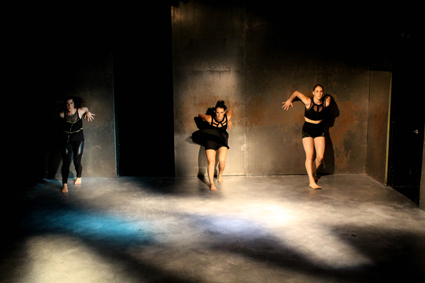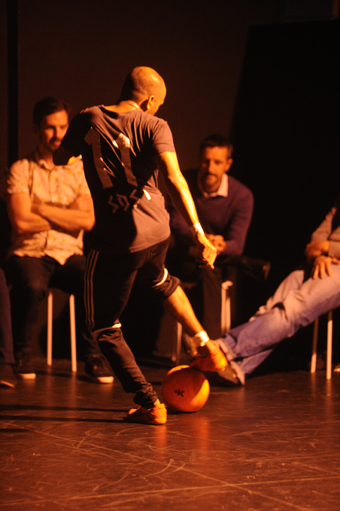 |
Verge photo Jennie Large |
Patrice Smith, in her relatively short career, has exhibited a fascination with transforming psychological behaviour into impressionistic embodied emotion. She could be seen to follow in the lineage of Mary Wigman’s Hexentanz or Martha Graham’s Lamentations, except that the interconnecting metaphorical threads arise less from direct expressionistic foundations than from the erratic patterning of neural pathways. Her compositional eye enables movement to build on abstracted bodily gestures and rhythms, physicalising hesitation, anxiety and violence without recourse to causal or narrative through-lines. Action rests and races on the verge of unwanted emergence.
However, the individuality of Smith’s three collaborating performers, Bernadette Lewis, Jacqui Claus and Laura Boynes, does imbue or mark distinctive ‘stories’ onto the work’s devolution, as does the unacknowledged presence of the shuddering and implacable corner of aluminium walls, the fourth player in this interrogation of consciousness. These act as visual barriers barring relief from the dissembling sense of control and, more expressively, as the sounding board against which the accumulating rage of three bodies is thrown. The silvered presence sends reverberations into and out of the dancers’ pressurised momentum.
Lewis initiates the states with a nonchalant downward focus on her feet and toes, playing with equilibrium. The action is concentrated and skilled in spite of its pedestrian slant. In the background, her fellow performers shift in response to a normal gravitational pull. Calmness pervades, edged only with an indistinct threat of imbalance. As Lewis’ experimentation gathers speed and complexity, Claus moves to the foreground, her figure replete with tension. With an awkward throw back of her head, which is repeated too often to be comfortable, Claus conveys an impression of retraction, of a stifled fear to move forward in the slow, long lines so suited to her extended physicality. Then the taut atmosphere snaps as Boynes runs at Claus and hits the wall. A fast-paced dissolution of balance, somewhere between violence and madness, whirls and smashes in the corner. Though remote from a romantic frame, Boynes’ distraught and unstoppable running and stumbling through the nether realms of consciousness reminded me of Giselle. Maybe dance is the domain of madness, that place where sanity is breached? The three, cornered women of Verge disappear over the edge of chaos into darkness.
 |
Ahilan Ratnamohan, SDS1 photo Ashley de Prazer |
A rudimentary single blue light illuminates a lone figure in the stadium, transposed in performance mode as a studio space with a single row of spectators seated around the perimeters. Two feet clad in orange trainers manoeuvre a matching orange ball, half-pivoting on its spherical colour. Though somewhat obscure in the low light, there is a suggestion that we are to be carried into a familiar yet divergent tale of a man and his extension into the world through a ball. Structurally, however, the work fractures into a stop-start pattern. Ratnamohan leaves the ball aside, box-dances in taut weight-shifts with his shoes emitting shrieking skids for no discernible reason.
Under an additional orange glow, the still darkened figure preoccupies himself with a random selection of soccer clichés: taping his ankles and binding his body, trotting the floor in circles of post-game adulation and pushing effort towards a forced condition of exhaustion. He coerces the audience to pass his body like a trophy around the field and inexplicably, for me, ‘head-butts’ with one of them. Near the performance’s end, full lights offer a clear image of the man, now returning to a gentler dance with the ball that resonates more with my memories of watching soccer. Handing over his sweaty shirt signals the moment of salutation to the crowd and his exit with his bag of balls.
In spite of my hesitations and disappointment with the lack of finesse and verve of a footballer’s consummate physicality, the non-contemporary dance audience seemed content with the patchwork of accustomed images of sport in performance and disinclined to demand any further meaning, beauty or drama of this man’s dance with a ball.
Verge, choreographer Patrice Smith, music, lighting Joe Lui, design Fiona Bruce, Lauren Ross, The Blue Room, 12-30 Nov; SDS1, choreographer and performer Ahilan Ratnamohan, PICA Performance Space, Perth, 27-30 Nov, 2013
RealTime issue #119 Feb-March 2014 pg. 30
© Maggi Phillips; for permission to reproduce apply to [email protected]








 back
back